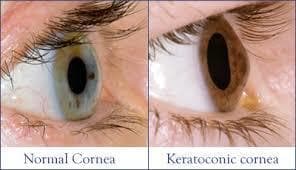Thin Corneas: Alternative to LASIK | EVO ICL

Have you been rejected as a LASIK candidate due to thin corneas?
This is one of the many cases for patients. After being turned away from LASIK surgery, many people believe they’ll never be free of contacts or glasses, but there is an excellent alternative to LASIK if you have thin corneas.
What are thin corneas?
The cornea is the transparent eye tissue that is located on the outermost layer of your eye. It functions to protect your eyes from dirt and germs along with filtering out small sounds of UV light.
Thin corneas are when the thickness falls below 500 microns (half a millimeter) since the average normal thickness of a cornea is about 540 microns.1
They can lead to a variety of vision symptoms that can have short term and long term effects. Additionally, it may disqualify you from being able to go through with certain eye surgeries.
If I Have Thin Corneas, Do I Qualify for LASIK?
The cornea is altered when LASIK is performed since it is responsible for how light enters your eye, influencing one’s scope of vision. During a LASIK procedure, the surgeon cuts a flap into the cornea, unhinges it and then uses a laser to cut away tissue to reshape it. The more nearsighted you are, the more tissue the doctor has to remove. After this procedure is completed, the flap is replaced and given time to heal.
With some patients, however, the corneas are not thick enough to withstand cutting. Cutting into these patients’ corneas could lead to a substantially weakened eye, something no one wants. Other problems can develop, as well, including ectasia, where the cornea becomes so weak it begins to bulge outward and can even lead to permanent blindness. A notable condition of corneal ectasia is keratoconus, where the cornea bulges outward, which can lead to worsening one’s vision.

People also consider alternative procedures such as LASEK, Epi-Lasik and PRK, but each of these involves removing tissue from the eye using a laser or blade.
Alternative Procedures to LASIK for Thin Corneas
Epi-Lasik
With this procedure, the flap is created from the topmost layer of the cornea. Final results of the procedure are usually seen as soon as three days and up to 3 - 6 months for one’s vision to completely stabilize.
LASEK
With the similar-sounding LASEK procedure, eye drops loosen the cells on top of the cornea, the cells are scraped to the side, a laser is applied to reshape the cornea, cells are smoothed back on and a contact lens is placed on top to help the healing. Final results from the surgery usually takes one to two weeks to fully heal and patients are usually required to wear a “bandage contact lens” for three to four days after the procedure.
PRK
During the PRK procedure, the outermost layer of the cornea is scraped, then reshaped. With PRK, no flap is created. Vision typically becomes completely clear and stable after one to three weeks or up to three to six months after surgery.
The EVO ICL (EVO)
Possibly one of the strongest choices for people with thin corneas are EVO ICLs (Implantable Collamer Lenses), a procedure that uses a biocompatible, advanced lens rather than cutting away eye tissue. As a bonus, the lens provides UV protection and does not promote dry eye syndrome. If needed, the lens can be removed. Results can usually be seen within the next few days after the 20 - 30 minute procedure.
Just because you have thin corneas, it doesn’t mean you’re out of luck.
References:
1 https://www.glaucoma.org/glaucoma/the-importance-of-corneal-thickness.php
If you're not a candidate for LASIK or are looking for a great alternative, contact a qualified EVO ICL surgeon today to learn about your options.
Important Safety Information
The EVO Visian ICL Lens is intended for the correction of moderate to high nearsightedness. EVO Visian ICL and EVO Visian TICL surgery is intended to safely and effectively correct nearsightedness between -3.0 D to -15.0 D, the reduction in nearsightedness up to -20.0 D and treatment of astigmatism from 1.0 D to 4.0 D. If you have nearsightedness within these ranges, EVO Visian ICL surgery may improve your distance vision without eyeglasses or contact lenses. Because the EVO Visian ICL corrects for distance vision, it does not eliminate the need for reading glasses, you may require them at some point, even if you have never worn them before.
Implantation of the EVO Visian ICL is a surgical procedure, and as such, carries potentially serious risks. Please discuss the risks with your eye care professional. Complications, although rare, may include need for additional surgical procedures, inflammation, loss of cells from the back surface of the cornea, increase in eye pressure, and cataracts.
You should NOT have EVO Visian ICL surgery if:
- Your doctor determines that the shape of your eye is not an appropriate fit for the EVO Visian ICL
- You are pregnant or nursing
- You have moderate to severe damage to the optic nerve caused by increased pressure (glaucoma)
- You do not meet the minimum endothelial cell density for your age at the time of implantation as determined by your eye doctor
- Your vision is not stable as determined by your eye doctor
Before considering EVO Visian ICL surgery you should have a complete eye examination and talk with your eye care professional about EVO Visian ICL surgery, especially the potential benefits, risks, and complications. You should discuss the time needed for healing after surgery. For additional information with potential benefits, risks and complications please visit DiscoverICL.com.
Select Your Region
Latin America
References
1. Packer M. The Implantable Collamer Lens with a central port: review of the literature. Clin Ophthalmol. 2018;12:2427-2438.
2. Martínez-Plaza E, López-Miguel A, López-de la Rosa A, et al. Effect of the EVO+ Visian Phakic Implantable Collamer Lens on Visual Performance and Quality of Vision and Life, Am J Ophthalmol 2021;226:117-125.
3. Packer M. Evaluation of the EVO/EVO+ Sphere and Toric Visian ICL: Six month results from the United States Food and Drug Administration clinical trial. Clinical Ophthalmology. 2022;16:1541-53.
4. Parkhurst GD. A prospective comparison of phakic collamer lenses and wavefront-optimized laser-assisted in situ keratomileusis for correction of myopia. Clin Ophthalmol. 2016;10:1209-1215.
5. Zhang H, Deng Y, Ma K, Yin H, Tang J. Analysis on the changes of objective indicators of dry eye after implantable collamer lens (ICL) implantation surgery. Graefes Arch Clin Exp Ophthalmol. 2024 Jul; 262(7):2321-2328
6. Shoja, MR. Besharati, MR. Dry eye after LASIK for myopia: Incidence and risk factors. Eur J of Ophthalmol. 2007; 17(1): pp. 1-6.
7. Lee, Jae Bum et al. Comparison of tear secretion and tear film instability after photorefractive keratectomy and laser in situ keratomileusis. J Cataract Refract Surg., Volume 26 , Issue 9 , 1326 - 1331.
8. Parkhurst, G. Psolka, M. Kezirian, G. Phakic intraocular lens implantantion in United States military warfighters: A retrospective analysis of early clinical outcomes of the Visian ICL. J Refract Surg. 2011;27(7):473-481.
Feeling unsure?
We get it. Decisions like this take time to consider and research. We can help guide your decision with information that's the most relevant to you.
Do you currently wear glasses or contacts?